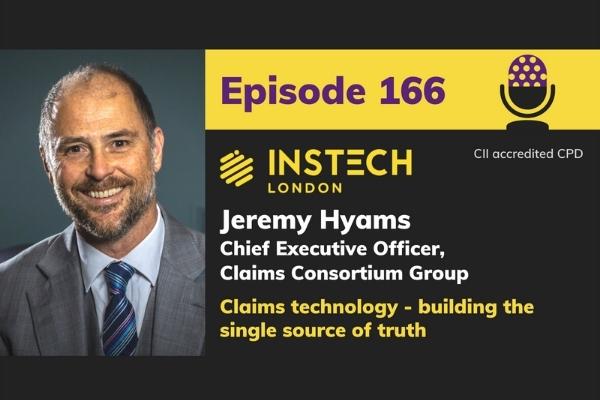When it comes to innovation, claims technology has not always got the level of focus it deserves.
That situation is changing though with several companies, including this week’s podcast guest, providing new technology solutions to speed up and improve claims processes.
Matthew talks to Jeremy Hyams, CEO and founder of Claims Consortium Group, about building a claims service provider, innovating at speed during Covid-19, and how its Synergy Cloud platform is helping the AA to manage home insurance claims in-house.
Talking points include:
- Claims handling technology in practice
- Building technology for third parties
- The growth in remote claims assessments
- Linking partners and customers through platforms
- Validating claims using real-time weather data
If you like what you’re hearing, please leave us a review on whichever platform you use, or contact Matthew Grant on LinkedIn.
Sign up to our newsletter for a fresh view on the world every Wednesday morning.
Continuing Professional Development – Learning Objectives
InsTech London is accredited by The Chartered Insurance Institute (CII). By listening to an InsTech London podcast, or reading the accompanying transcript, you can claim up to 0.5 CPD hours towards the CII member CPD scheme.
The Learning Objectives for this podcast are:
- Explore why only a small proportion of investment by insurers goes into claims
- Understand what claims handling technology is
- Compare some of the trends around remote claims assessment technology
Let us know you have listened to this podcast by emailing [email protected] and if your organisation is a member of InsTech London you will receive a quarterly summary of the CPD hours you have earned.
To help us measure the impact of the learning, we would be grateful if you would take a minute to complete a quick feedback survey.
Claims technology – building the single source of truth – Episode 166 highlights
Matthew: Could you talk about what motivated you to found Claims Consortium?
Jeremy: Claims Consortium was set up in 1996 and has grown from five people to around 300 people. Claims Consortium is a claims handling business. We work within the household, commercial, leisure and liability spaces. We offer services including subsidence, third party motor damage claims and repair validation. We also carry out the necessary repairs or arrange those repairs on behalf of the insurer. We can provide loss adjusting for complex or contentious claims. Our growth has been organic up until the last couple of years and then we started acquiring businesses, such as WeatherNet, through self-funding.
Matthew: You’ve moved from being a service provider to now also building technology for third parties. What motivated you to start building technology yourselves?
Jeremy: Claims Consortium’s technology was initially only used internally as a way for us to better service our customers. Over the years we’ve realised that our technology and knowledge is valuable as we understand claims and customers so well. 2020 was a pivotal year when we moved into technology and data and built a claims management system. We had support from the AA, a British motoring association, in developing the system.
Matthew: There are many other companies offering claims management system technology. Why do you think the AA chose Claims Consortium rather than a company that already had an existing system?
Jeremy: We developed our system from a claim-centric place which enabled the AA to be confident that we could deliver exactly what they were after. Additionally, the deployment of our technology required no upfront costs because it’s Software as a Service (SaaS).
Matthew: In the past five years there’s been around $30 billion in investments into new technology within insurers. According to Willis, only 18% of that has gone into claims. Insurers don’t seem to be focusing on using new technology for claims as much as they should be given the clear cost savings potential. Why do you think that is?
Jeremy: If insurers want to significantly reduce their loss ratio, claims is where they should be focusing. Over lockdown, there has been an increase in innovation in this area, mainly from insurers. I think innovation can still come from the claims handling companies themselves. The onus is on these existing claims companies to look at their own businesses to create software that’s going to future-proof themselves.
Matthew: For those that are not familiar with what claims handling technology looks like, can you step us through a real-life example?
Jeremy: We offer an end-to-end claims management system, meaning it starts from the customer being able to notify about their claim: FNOL (First Notification Of Loss). The system does everything through to registration and validation. Validation includes the system being able to read the policy, understand the limits and understand the exclusions. It then determines how much should be paid and goes all the way through to settlement.
The claims management system we built for the AA is integrated with Cue (household claims database) and our WeatherNet databases. It also integrates with the AA’s communication suite such as emails, SMS and phone systems, and their finance package. We are providing the AA with one platform that controls everything needed for the claims process. In addition to that, the customer, claims advisor and supplier are all integrated on the same system. This means there is one version of truth and there is clear communication between all parties. This allows for one claims advisor to deal with the whole claim.
Matthew: You provide information extraction as part of the claims validation process. Data ingestion and extraction is a hot topic right now – we released our InsTech report on it earlier this year. Does this mean that you’re building an approach that can work across multiple different policy forms?
Jeremy: The system we have built can read lots of different policy forms. Once the data is ingested and validated everyone in the supply chain accesses the same information, from claims advisor, adjustors, surveyors, and tradespeople. The repair costs, for example, are visible to all, and as they are fixed amounts defined in the system an overspend is impossible. Everyone accessing the online system has the same experience whether they be a claims advisor in the office or an onsite tradesperson.
Matthew: When it comes to building technology, what would be your advice to those that are looking to find a technology partner?
Jeremy: It’s important for the team to share the same vision and to have the right team to execute that vision. It is also about serendipity – being in the right place at the right time. An interesting thing about our work for the AA is that I don’t think we would have been able to build the platform if we weren’t in lockdown. The AA and other insurers were unlikely to have accepted video calls before. This meant that the organisational complexity was cut away, and our team built the software without ever leaving our homes. This was the single biggest driver that allowed us to create the system so quickly. We also found it very valuable that the team at the AA had the same vision as us despite working remotely and that we had a shared culture. Having clients with a good culture fit is another important aspect in successfully growing a business.
Matthew: The UK lockdown over 2020 also drove an increase in claims being handled remotely. What trends have you seen in the last year around remote claims assessment technology?
Jeremy: Over lockdown, there’s been an explosion of video technology. There are some great companies offering live streaming and storage of videos to support remote claims assessment. The costs can be quite high due to the need for video compression and complicated algorithms. We are seeing new solutions emerging as companies like Twilio and Microsoft Teams are opening up their technology, offering APIs to developers, which enables their technology to be integrated into a developer’s platform. This is likely to reduce the cost of creating simple tools.
Matthew: Do you think moving towards net zero carbon emissions will drive further growth in remote claims assessments?
Jeremy: Over lockdown, especially on the small claims side, there were up to 50% more claims being settled remotely. As we’ve come out of lockdown, this seems to be reducing to around 10%. People still seem to like having someone come round to assess the claim, so the case for remote claims assessment isn’t yet fully proven. Growing recognition of carbon emissions and a drive to net-zero by insurers is likely to lead to them encouraging their supply chains to undertake more remote assessments, rather than personal visits, where possible. This is likely to drive an uptick back to more remote assessments over time. Fully remote assessment is unlikely as some customers are reluctant to have the responsibility of having to deal with a claim over the phone or a mobile device, and they don’t want to have to act as the surveyor. As well as this, we are seeing a number of insurers go back to physical visits as they are not ready or confident enough to use remote claims assessments applications.
Matthew: You acquired WeatherNet earlier this year. Can you talk a bit about that?
Jeremy: Before we acquired WeatherNet, the service was able to measure wind, rain, snow, hail and lightning at 300 weather stations across the UK. A user could type in a date of loss and a postcode, and they would receive a weather record for that time and place that could be used to help adjust the claim. Since acquiring WeatherNet, we’ve started to use new technology to identify weather conditions between the physical weather stations. Now data is being gathered from the equivalent of 82,000 locations across the UK. Data is recorded every five minutes, so it’s almost in real-time. WeatherNet also has access to half a trillion records of historical weather data.
Matthew: How does the WeatherNet acquisition fit into your claims workflow technology Synergy?
Jeremy: Through the precise, accurate and real-time data that we’re getting through WeatherNet and the validation tools that we have through Synergy, a customer can input their claim. The system can immediately identify if it is a valid claim, and how it should be handled. The claim can be automatically processed by declining it, offering a cash settlement, or triaging it through the system to connect to the right organisations to deal with the loss. This takes a lot of the uncertainty out of the claims process.
Matthew: Why did you become a corporate member of InsTech London?
Jeremy: Insurtech is a new world to me. There’s this huge ecosystem out there with so many vibrant and exciting companies. For example, if you asked me a year and a half ago what parametric insurance was, I would have no idea, but as a result of InsTech London, I now understand how it fits into the bigger insurance picture. I’m learning so much from the InsTech London community.
Matthew: For those listening, what would you like their key takeaway to be about Claims Consortium?
Jeremy: We’ve got a huge amount of experience in lots of different areas. We’ve been working within claims for 30 years, and now we have our own technology offering. I love talking to people and helping them understand more about what is happening in claims. I welcome anyone to reach out to me on LinkedIn whether they be from an insurer or technology company.






